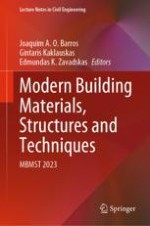2024 | OriginalPaper | Chapter
Verification of the Concrete Slab in Timber-Concrete Composite Structures
Authors : Klaus Holschemacher, Ulrike Quapp
Published in: Modern Building Materials, Structures and Techniques
Publisher: Springer Nature Switzerland
Activate our intelligent search to find suitable subject content or patents.
Select sections of text to find matching patents with Artificial Intelligence. powered by
Select sections of text to find additional relevant content using AI-assisted search. powered by
